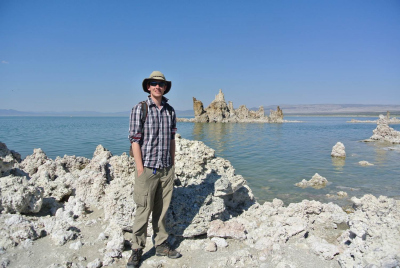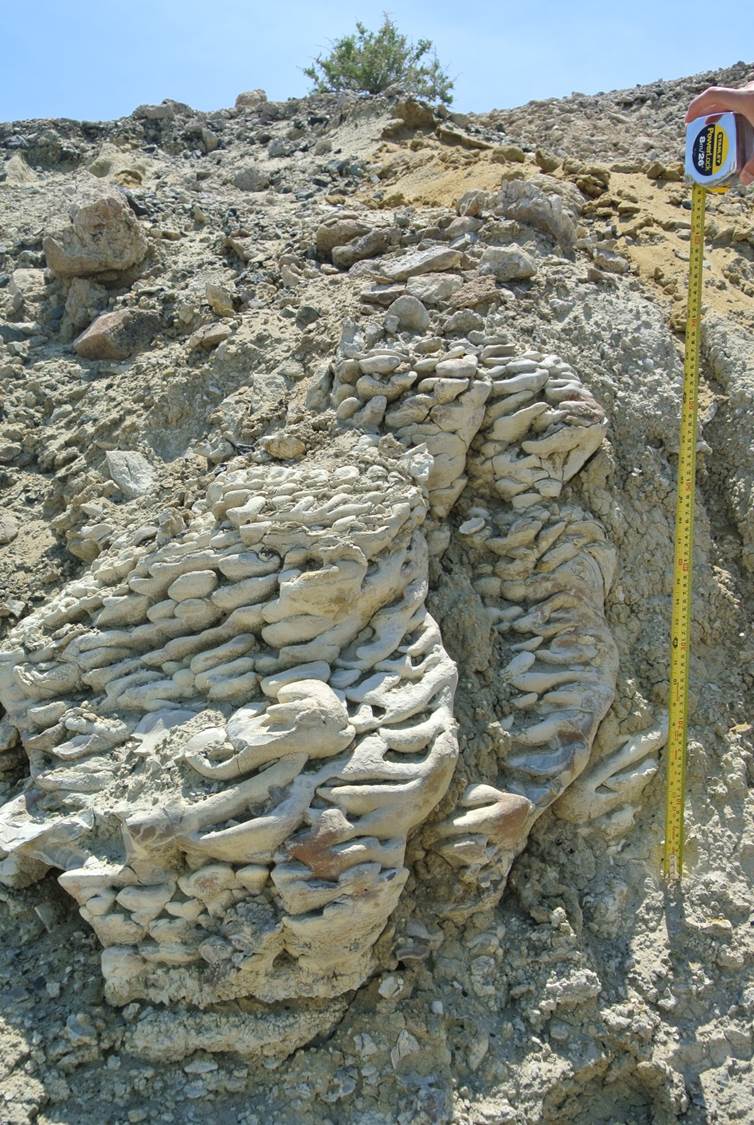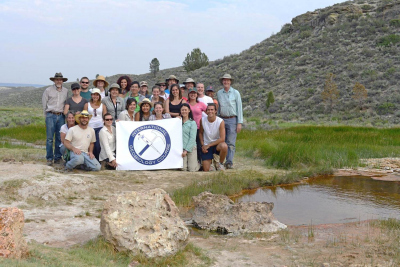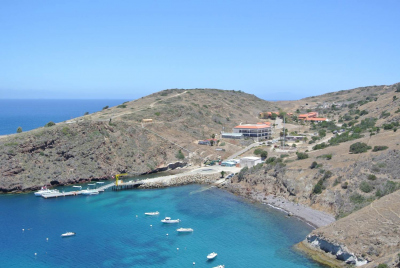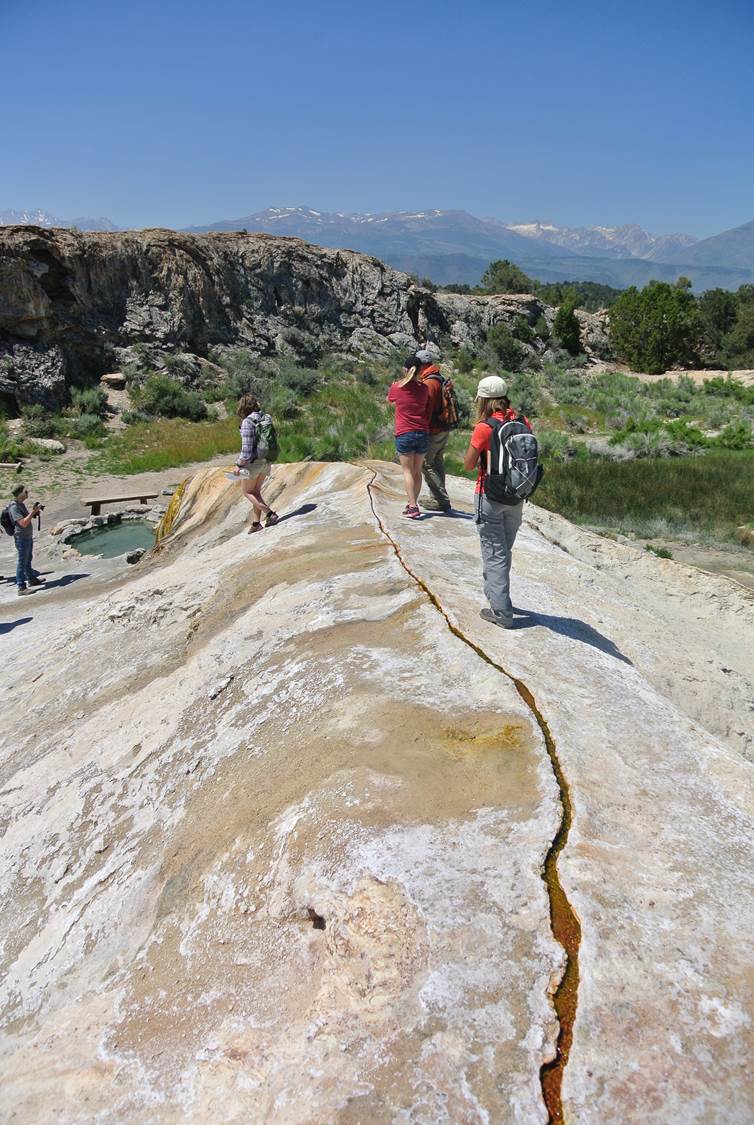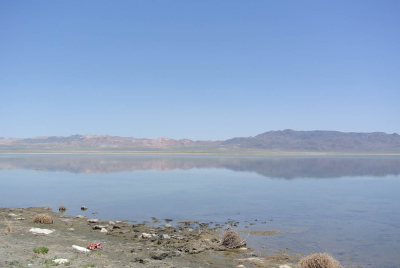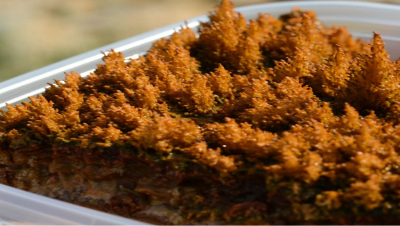Die Inhalte dieser Seite sind leider nicht auf Deutsch verfügbar.
Seitenpfad:
- Graduate School GLOMAR
- PhD student reports
- Conference Reports
- Conference Reports 2015
- Lennart van Maldegem
Lennart van Maldegem
Report of GLOMAR PhD student Lennart van Maldegem about his participation in the NASA Astrobiology Conference in Chicago, USA from 15 – 19 June 2015 and in the 2015 Agouron International Geobiology Course on Catalina Island, USA from 19 June – 22 July 2015
Thanks to GLOMAR I was able to attend both the Astrobiology Science Conference 2015 as wells as the International Geobiology Course. The Astrobiology conference lasted for 5 days at the Chicago Hilton Hotel and started every morning with a general assembly in the grand ballroom with some inspiring keynote speeches about the evolution of life, the formation of biomolecules and the habitability of exoplanets as well as panel discussions about the upcoming NASA Mars 2020 mission. After each keynote session the conference moved to smaller rooms where parallel presentations were given.
The conference provided me a platform to present my work via an oral presentation during the session Mission to Early Earth, Co-Evolving Archean and Proterozoic Oceans, Atmospheres, and Life III, where I presented my latest work towards the dynamics of the pre-Sturtian carbon cycle. Besides presenting my own work I was able to listen to what research other groups in the field are currently working on. During the conference I was able to have informal meetings with multiple leading scientists to discuss about the future developments in the field of pre-Cambrian organic geochemistry and possible collaborations.
A large selection of the oral presentations from AbSciCon can be found online at: https://astrobiology.nasa.gov/seminars/featured-seminar-channels/conferences-and-workshops/2015/6/15/abscicon-2015/
After AbSciCon I flew directly to Los Angeles to attend the International Geobiology Course. This course offers every year the opportunity to 15 PhD students from around the world to gain specialized knowledge in the complex interplay between biological and geological processes. The almost 5 week lasting course is constructed around a combination of fieldwork, novel technique workshops, lectures from leading geobiologists and a research project leading potentially leading to conference abstracts and publications.
After arriving at the University of Southern California in Los Angeles the course kicked off with an ice breaker dinner between the attending students and the instructors of the course. The next day we got a brief introduction towards geology and biology before we left for a field trip to the Eastern Sierra Nevada, USA. From our home base in Mammoth Lakes, we drove to several hot springs and soda lakes to study there unique biological and geological features. At the field sites we collected samples for the projects which we would work on later in the course. Our evenings during the fieldtrip were filled with evening lectures. After the lectures the student were asked each day to please upload all the collected sample information from that day in the digital notebook.
After 5 days in the field we drove back to Los Angeles where we took up residence at California State University Fullerton. In Fullerton we were split in groups to conduct biological and geological rotations (i.e. DNA extraction, bioinformatics, geochemistry and petrography) on the samples we gathered from the field. The evenings were filled with oral presentations from every participating student about their own research followed by 20 minutes of questions from the member in the audience.
After completing all rotations the samples, which needed external analysis were shipped away (i.e. clumped isotopes, radiocarbon dating, trace metals composition, sulfur analysis, thin sections, metagenome and 16S analysis) in the meanwhile we moved from Fullerton to the USC Wrigley Marine Center for Environmental Sciences at Catalina Island just off the coast of Los Angeles. During the day in our first week at Catalina Island many flown in guest lecturers gave us lectures and workshops on all aspects of geobiology, while in the evenings they gave inspiring talks about their own research.
In the final week the students were split into 4 groups. Each group was assigned a geobiological project from one of the sites visited in the first week. Using the collected and processed data a research had to be conducted in which the newly learned techniques were immediately put to use, the results were presented in a 25 minute presentation on the final day of the summer course. I chose to work on the project: The biogeochemistry of the past and present Walker Lake, Nevada. USA. The first part of the project consisted out of the research of the formation of clay firmgrounds which might have the potential to be recorded in the rock record. A major question which we asked was if these firmgrounds are biogenic produced or not. We analyzed the water chemistry on trace metals and nutrient, collected pore water samples from cores and analyzed the microbial community present at the top and in the depth using 16S and metagenomics analysis.
The conference provided me a platform to present my work via an oral presentation during the session Mission to Early Earth, Co-Evolving Archean and Proterozoic Oceans, Atmospheres, and Life III, where I presented my latest work towards the dynamics of the pre-Sturtian carbon cycle. Besides presenting my own work I was able to listen to what research other groups in the field are currently working on. During the conference I was able to have informal meetings with multiple leading scientists to discuss about the future developments in the field of pre-Cambrian organic geochemistry and possible collaborations.
A large selection of the oral presentations from AbSciCon can be found online at: https://astrobiology.nasa.gov/seminars/featured-seminar-channels/conferences-and-workshops/2015/6/15/abscicon-2015/
After AbSciCon I flew directly to Los Angeles to attend the International Geobiology Course. This course offers every year the opportunity to 15 PhD students from around the world to gain specialized knowledge in the complex interplay between biological and geological processes. The almost 5 week lasting course is constructed around a combination of fieldwork, novel technique workshops, lectures from leading geobiologists and a research project leading potentially leading to conference abstracts and publications.
After arriving at the University of Southern California in Los Angeles the course kicked off with an ice breaker dinner between the attending students and the instructors of the course. The next day we got a brief introduction towards geology and biology before we left for a field trip to the Eastern Sierra Nevada, USA. From our home base in Mammoth Lakes, we drove to several hot springs and soda lakes to study there unique biological and geological features. At the field sites we collected samples for the projects which we would work on later in the course. Our evenings during the fieldtrip were filled with evening lectures. After the lectures the student were asked each day to please upload all the collected sample information from that day in the digital notebook.
After 5 days in the field we drove back to Los Angeles where we took up residence at California State University Fullerton. In Fullerton we were split in groups to conduct biological and geological rotations (i.e. DNA extraction, bioinformatics, geochemistry and petrography) on the samples we gathered from the field. The evenings were filled with oral presentations from every participating student about their own research followed by 20 minutes of questions from the member in the audience.
After completing all rotations the samples, which needed external analysis were shipped away (i.e. clumped isotopes, radiocarbon dating, trace metals composition, sulfur analysis, thin sections, metagenome and 16S analysis) in the meanwhile we moved from Fullerton to the USC Wrigley Marine Center for Environmental Sciences at Catalina Island just off the coast of Los Angeles. During the day in our first week at Catalina Island many flown in guest lecturers gave us lectures and workshops on all aspects of geobiology, while in the evenings they gave inspiring talks about their own research.
In the final week the students were split into 4 groups. Each group was assigned a geobiological project from one of the sites visited in the first week. Using the collected and processed data a research had to be conducted in which the newly learned techniques were immediately put to use, the results were presented in a 25 minute presentation on the final day of the summer course. I chose to work on the project: The biogeochemistry of the past and present Walker Lake, Nevada. USA. The first part of the project consisted out of the research of the formation of clay firmgrounds which might have the potential to be recorded in the rock record. A major question which we asked was if these firmgrounds are biogenic produced or not. We analyzed the water chemistry on trace metals and nutrient, collected pore water samples from cores and analyzed the microbial community present at the top and in the depth using 16S and metagenomics analysis.
For the second part of the project we investigated a three meter thick stromatolite bed just east of Walker Lake. Stromatolites are a special type of fossil because they do not move and therefor record the environmental signal during formation. Radiocarbon dating of the Walker Lake Stromatolites showed that they were formed between 41000 and 36000 years ago. The stromatolites in Walker Lake are due to this research the best dated ones in the world and using petrography distinct similarities were found between the Walker Lake stromatolites and stromatolites formed in the Proterozoic (between 2.4 and 0.5 billion years ago) making the Walker Lake stromatolites a potential important modern analog for understanding stromatolite forming in the Early Earth. Analysis with clumped isotopes and trace metals showed that the formation of the Walker Lake stromatolites occurred in waters with highly varying temperature and alkalinities. To understand how the ancient Walker Lake changed over time and how that affected the forming of stromatolites. We reconstructed the lake level change during the time of formation by combining modelling with geochemical data and previous bathymetry studies. Both parts of the Walker Lake projects are submitted to the AGU 2015 as well as the GSA 2015 conference.
AGU abstract link:
https://fallmeeting.agu.org/2015/abstract/paleoenvironmental-reconstruction-of-40ka-stromatolites-from-the-ancient-lake-lahontan-nevada-usa/
For me personally the Geobiology Summer Course was an amazing scientific adventure which I will cherish for my entire life. I strengthened my network besides gaining so much new specialized knowledge via the lectures and workshops which were provided by all leading scientists. Because of the project I will be collaborating with a large portion of the students and instructors in the future.
I would like to thank GLOMAR and the Agouron Institute for financial support, also I would like to thank 2015 GeoBio Cohort for making the course so amazing but I especially would like to thank Team Walker Lake; Laura, Lu and Joy! Lastly I would like to thank all the instructors, supporting staff and guest lecturers who invested so much time and energy in making this course amazing.
AGU abstract link:
https://fallmeeting.agu.org/2015/abstract/paleoenvironmental-reconstruction-of-40ka-stromatolites-from-the-ancient-lake-lahontan-nevada-usa/
For me personally the Geobiology Summer Course was an amazing scientific adventure which I will cherish for my entire life. I strengthened my network besides gaining so much new specialized knowledge via the lectures and workshops which were provided by all leading scientists. Because of the project I will be collaborating with a large portion of the students and instructors in the future.
I would like to thank GLOMAR and the Agouron Institute for financial support, also I would like to thank 2015 GeoBio Cohort for making the course so amazing but I especially would like to thank Team Walker Lake; Laura, Lu and Joy! Lastly I would like to thank all the instructors, supporting staff and guest lecturers who invested so much time and energy in making this course amazing.
Lennart at Mono Lake, California
Photo: Lennart van Maldegem
Walker Lake east stromatolites, Nevada
Photo: Lennart van Maldegem
Geobiology cohort 2015
Photo: Ann Close
USC Wrigley Institute for Environmental Sciences, Catalina Island, California
Photo: Lennart van Maldegem
Sampling of Travertine Hotspring, California
Photo: Lennart van Maldegem



